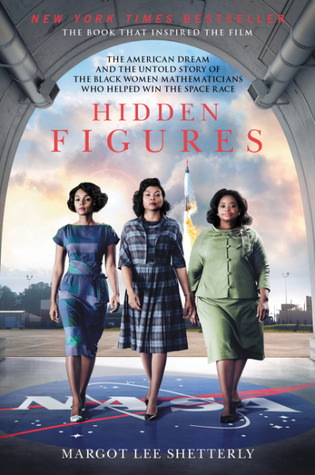
by fljustice | Mar 3, 2018 | Books, History, Reviews, Wonderful Women
Hidden Figures:
The American Dream and the Untold Story of the Black Women Mathematicians Who Helped Win the Space Race
by Margot Lee Shetterly
“Before John Glenn orbited the earth, or Neil Armstrong walked on the moon, a group of dedicated female mathematicians know as “human computers” used pencils, slide rules, and adding machines to calculate the numbers that wo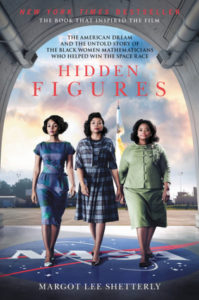 uld launch rockets, and astronauts, into space.
uld launch rockets, and astronauts, into space.
Among these problem-solvers were a group of exceptionally talented African American women. Originally math teachers in the South’s segregated public schools, these gifted professionals answered Uncle Sam’s call during the labor shortages of World War II. With new jobs at the fascinating, high-energy world of the Langley Memorial Aeronautical Laboratory in Hampton, Virginia, they finally had a shot at jobs that would push their skills to the limits.”
Hidden Figures is my transition book from Black History Month to Women’s History Month. It showcases a quartet of significant–but little known–African American women mathematicians. I saw the movie and knew I wanted to read the book. It was obvious that the movie took a lot of “artistic license,” but the underlying story of black women mathematicians at NASA was so compelling, I had to find out the “real” vs. the “reel” of the movie.
Shetterly did not disappoint. (more…)
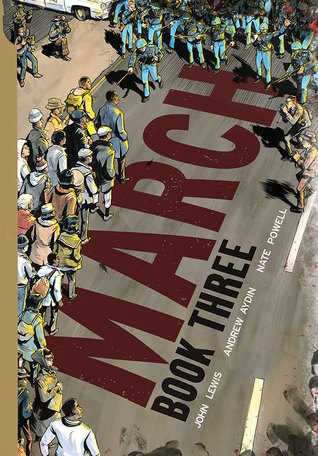
by fljustice | Feb 26, 2018 | Biographies, Books, History, Reviews
March: Book Three
by John Lewis, Andrew Aydin (co-authors), Nate Powell (Illustrator)
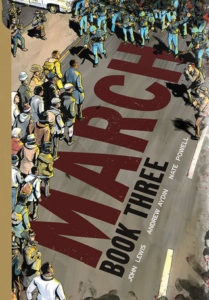 I finished the third volume in civil rights icon John Lewis’ graphic memoir about his early days in the movement leading up to the march from Selma to Montgomery, Alabama. (If you missed it my review of the first two books is here.) March: Book Three is the longest of the trilogy and covers the shortest amount of time. It opens in September 1963 with the bombing of the Sixteenth Street Baptist Church in Birmingham which killed four young girls. Everyone remembers the horror of that act of terrorism, but I didn’t know this was the church’s annual “Youth Day” and 24 other children were injured. The terrorists deliberately targeted African American children in their church. Shortly after that, a group of Eagle Scouts, who had just attended a clan rally, shot a 13-year-old black boy from his bicycle and killed him; and a police officer shot and killed a 16-year-old black youth who chucked a rock at a car full of teens who were celebrating the deaths of the girls. The book continues through to March 7, 1965, Bloody Sunday in Selma which included the beating death of Unitarian minister James Reeb, the later peaceful march to Montgomery, and the assassination of Viola Liuzzo, a 39-year-old mother from Detroit who was shuttling volunteers from Birmingham back to Selma. Four months later on August 6, President Johnson signed the 1965 Voting Rights Act into law. (more…)
I finished the third volume in civil rights icon John Lewis’ graphic memoir about his early days in the movement leading up to the march from Selma to Montgomery, Alabama. (If you missed it my review of the first two books is here.) March: Book Three is the longest of the trilogy and covers the shortest amount of time. It opens in September 1963 with the bombing of the Sixteenth Street Baptist Church in Birmingham which killed four young girls. Everyone remembers the horror of that act of terrorism, but I didn’t know this was the church’s annual “Youth Day” and 24 other children were injured. The terrorists deliberately targeted African American children in their church. Shortly after that, a group of Eagle Scouts, who had just attended a clan rally, shot a 13-year-old black boy from his bicycle and killed him; and a police officer shot and killed a 16-year-old black youth who chucked a rock at a car full of teens who were celebrating the deaths of the girls. The book continues through to March 7, 1965, Bloody Sunday in Selma which included the beating death of Unitarian minister James Reeb, the later peaceful march to Montgomery, and the assassination of Viola Liuzzo, a 39-year-old mother from Detroit who was shuttling volunteers from Birmingham back to Selma. Four months later on August 6, President Johnson signed the 1965 Voting Rights Act into law. (more…)
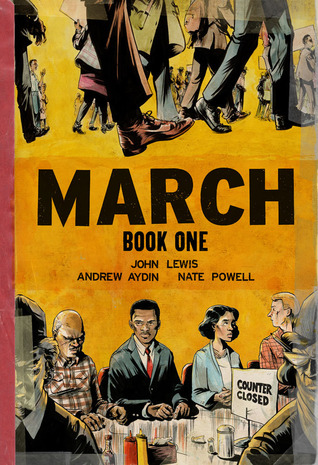
by fljustice | Feb 19, 2018 | Biographies, Books, History, Reviews
March: Book One and March: Book Two
by John Lewis, Andrew Aydin (Co-authors), Nate Powell (Artist)
Blurb:
March is a vivid first-hand account of John Lewis’ lifelong struggle for civil and human rights, meditating in the modern age on the distance traveled since the days of Jim Crow and segregation. Rooted in Lewis’ personal story, it also reflects on the highs and lows of the broader civil rights movement.
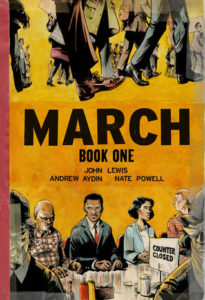 Continuing with my Black History Month project, I finished Representative John Lewis’ trilogy of graphic books: March. These three books are a remarkable achievement and recommended for adults and children alike. Lewis, a true American treasure and Civil Rights icon, wrote a couple of traditional memoirs based on his role in the Civil Rights struggles. This graphic project was inspired by an early “comic” about Dr. Martin Luther King that circulated during those turbulent times and inspired many young people to join the fight. The lead up to, and march for, voting rights in Selma, Alabama is laid out in touching detail.
Continuing with my Black History Month project, I finished Representative John Lewis’ trilogy of graphic books: March. These three books are a remarkable achievement and recommended for adults and children alike. Lewis, a true American treasure and Civil Rights icon, wrote a couple of traditional memoirs based on his role in the Civil Rights struggles. This graphic project was inspired by an early “comic” about Dr. Martin Luther King that circulated during those turbulent times and inspired many young people to join the fight. The lead up to, and march for, voting rights in Selma, Alabama is laid out in touching detail.
Book One is the shortest of the three but covers the most time of the trilogy. It deals with Lewis’ early years, his struggle (even against his parents) to get an education and his growing sense of injustice in the segregated south. John Lewis struggled and “pulled himself up by his bootstraps” against enormous odds. This book lays the foundation for everything that is to come, everything that shaped his personality and made him the formidable man he was to become. It concludes with the successful integration of Nashville, Tennessee’s downtown drug store counters. We get a behind the scenes look at the politics and strategies employed by a dedicated group of young people working to make their world more fair: the first steps in the Civil Rights movement. I particularly liked the framing story–the morning of President Obama’s first inauguration–which gave the narrative poignancy. (more…)

by fljustice | Feb 12, 2018 | Biographies, Books, History, Reviews
Book Review: Narrative of the Life of Frederick Douglass, an American Slave and Other Writings
Blurb:
“This dramatic autobiography of the early life of an American slave was first published in 1845, when its young author had just achieved his freedom. Douglass’ eloquence gives a clear indication of the powerful principles that led him to become the first great African-American leader in the United States.”
Welcome to Black History Month!
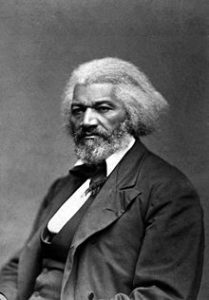
Frederick Douglass c 1874
I always look forward to February and March because it puts the spotlight on two marginalized groups in history. As a history geek, I would prefer that we didn’t need those spotlights, but given the current political backlash against all “others,” I don’t think we’ll be reaching that point soon. So one of my contributions this year is a review of the venerable autobiography of Frederick Douglass, an escaped american slave, abolitionist, preacher and revered leader of the African American community. As a scholar of ancient history, I value primary sources (which are few in my chosen time of 5C Rome). This autobiography is a precious record of a troubling period in our American History from a man who experienced it first hand. This is a classic of American literature and a rebuke to all folks who insist that the Civil War was fought over “heritage.” (more…)
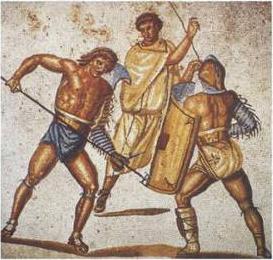
by fljustice | Oct 5, 2015 | Essays/Research, Gladiators, Gladiatrix, History
A Day at the Pompeii Arena
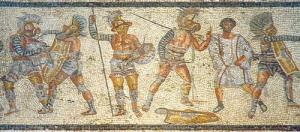 It’s a sunny day in Pompeii on April 8th in this first year of the reign of Imperator Titus Caesar Vespasianus Augustus (AD 79). The crowds surge toward the amphitheater for the games given by D. Lucretius Stater Valens, a lifelong priest to the cult of the deified Nero Caesar Augustus. The placards pasted on the walls in the forum promise, “ten pairs of gladiators owned by his son D. Lucretius Valens and wild animal hunts, as permitted by law. The seats will be shaded with awnings.” Pompeii’s is the oldest stone amphitheater in the empire. For one hundred-fifty years it has proudly hosted games and religious festivals, but it’s looking dated next to the modern Flavian Amphitheater which will open next year in Rome. The frescoes of gladiatorial combat and beast hunts decorating the walls surrounding the sand are fading, but the patrons come for the blood sports, not the art.
It’s a sunny day in Pompeii on April 8th in this first year of the reign of Imperator Titus Caesar Vespasianus Augustus (AD 79). The crowds surge toward the amphitheater for the games given by D. Lucretius Stater Valens, a lifelong priest to the cult of the deified Nero Caesar Augustus. The placards pasted on the walls in the forum promise, “ten pairs of gladiators owned by his son D. Lucretius Valens and wild animal hunts, as permitted by law. The seats will be shaded with awnings.” Pompeii’s is the oldest stone amphitheater in the empire. For one hundred-fifty years it has proudly hosted games and religious festivals, but it’s looking dated next to the modern Flavian Amphitheater which will open next year in Rome. The frescoes of gladiatorial combat and beast hunts decorating the walls surrounding the sand are fading, but the patrons come for the blood sports, not the art.
The spectators pass into the open spaces surrounding the arena where merchants and food vendors hawk their wares. The scent of fresh bread, roasted meats, and sour wine waft through the crowd to mingle with the odor of sweat and hair pomade. People look at their wooden tickets and enter the appropriate gate to spread throughout the amphitheater: the front rows reserved for the leading citizens; the middle for the lesser knights and merchants; and the top for the poor, slaves, and women. Some resent the class divisions at the arena. At the chariot races in the hippodrome, it’s open seating (except for the emperor, of course!) and women mix with the men. (more…)
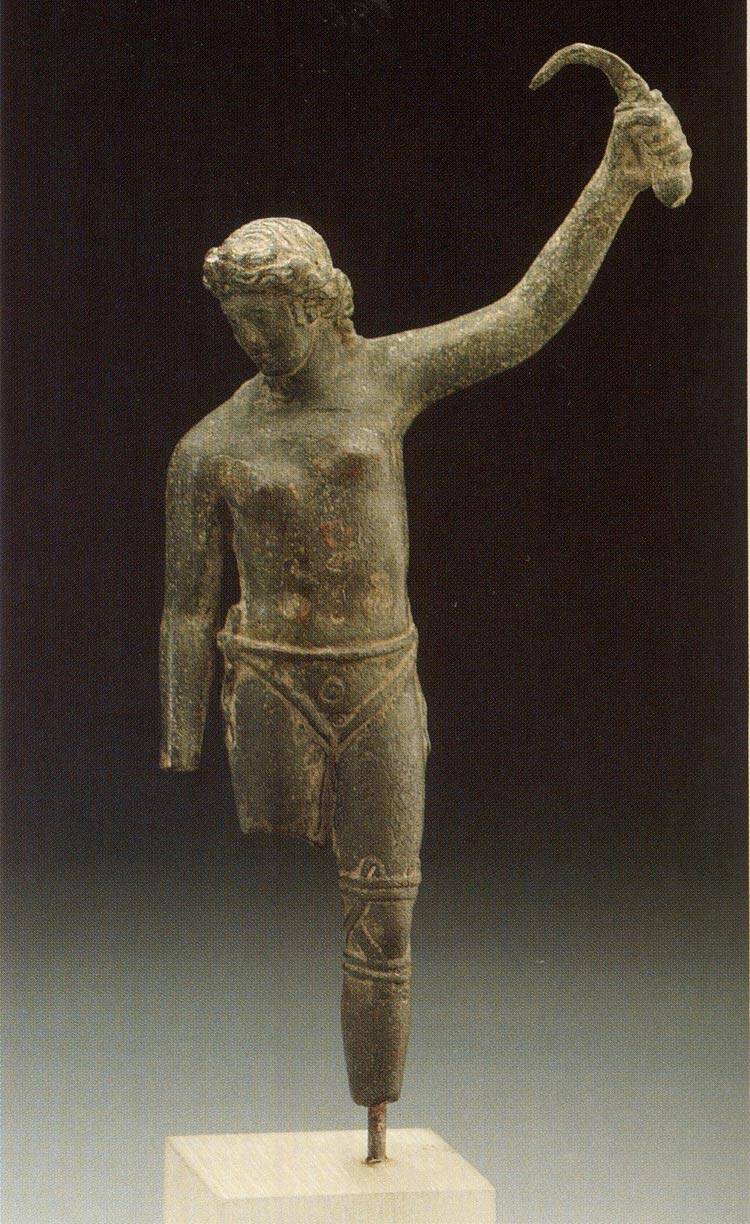
by fljustice | Sep 9, 2015 | Essays/Research, Gladiators, Gladiatrix, History, Movies
Busting Gladiator Myths
Before I researched my novel, Sword of the Gladiatrix, I got most of my ideas and impressions of gladiators from the media: Russell Crowe in Gladiator and (for those of us of a certain age) Kirk Douglas in Spartacus. More recently Starz had a fantastic (in more ways than one) show that ran for three seasons titled Spartacus: War of the Damned. All of these shows perpetuate some gladiator myths that I hope to bust wide open in this post. They also got a couple of things right, which I’ll point out.
Myth #1:
All gladiators were men.

Bronze statue of a gladiatrix
Most were, but not all. Here I’ll give Gladiator a weak thumbs up—they had women in chariots fighting against a group of men in a re-enactment of a classic battle in an arena scene, but other than that, women gladiators don’t show up in most visual media. It’s left to us lowly writers to correct the balance. If you look closely, women in the arena show up in art, literature, and law.
Sword of the Gladiatrix was inspired by a particular stone carving of two female gladiators in the British Museum. More recently, archaeologists have uncovered a bronze statue of a gladiatrix holding a sica—a curved sword. Tacitus, Suetonius, Dio, Martial, and Juvenal all write about female gladiators—usually (except for Martial) with some element of dismay or sarcasm. An organizer in Ostia brags on his tombstone that he was the first person to put women in the arena as fighters. My favorite evidence is in the law: The first Roman Emperor Augustus forbade recruiting noble and free women as gladiators. Nearly two hundred years later, Emperor Septimus Severus banned single combat by women in the arena. If women weren’t being recruited and fighting, why have a ban? Human nature being what it is, these prohibitions probably made the fights all the more popular because they were illegal. I’m sure female gladiatorial contests continued for some time. (more…)

uld launch rockets, and astronauts, into space.









